金橘Citrus japonica
中文名(Chinese Name):金橘
学名(Scientific Name):Citrus japonica Thunb.
英文名(English Common Name):
别名(Chinese Common Name):牛奶柑、公孙橘、金柑
异名(Synonym):
科属(Family & Genus):芸香科(Rutaceae)金橘属
形态特征(Description):
分布(Distribution):未见有野生,南方各地栽种。
用途(Use):
引自中国植物志英文版
Loureiro; C. margarita Loureiro; C. ×nobilis Loureiro var. inermis (Roxburgh) Sagot; Fortunella chintou (Swingle) C. C. Huang; F. crassifolia Swingle; F. hindsii (Champion ex Bentham) Swingle; F. hindsii var. chintou Swingle; F. japonica (Thunberg) Swingle; F. margarita (Loureiro) Swingle; F. obovata Tanaka; F. venosa (Champion ex Bentham) C. C. Huang; Sclerostylis hindsii Champion ex Bentham; S. venosa Champion ex Bentham.
Trees to 5 m tall, d.b.h. to 20 cm. Branchlets numerous; spines variable, to 5 cm on young growth but some only a few mm on flowering shoots. Leaves 1-foliolate or sometimes mixed with simple leaves; petiole 6-9 mm, narrowly winged; leaf blade elliptic to obovate-elliptic, 4-6 × 1.5-3 cm, base rounded to broadly cuneate, margin dentate near apex or rarely entire, apex rounded and rarely mucronate. Flowers solitary or fascicled, subsessile. Calyx 4- or 5-lobed. Petals 5, ca. 5 mm or less. Stamens ca. 20; filaments cohering into 4 or 5 bundles. Ovary as long as style, 3- or 4-loculed, with 3 or 4 ovules per locule. Fruit bright orange to red, globose to slightly oblate, 9-10 mm in diam., smooth, 3- or 4-seeded; pericarp sweet and edible; sarcocarp acidic. Seeds broadly ovoid, apex mucronate; seed coat smooth; embryos at least sometimes numerous; cotyledons green. Fl. Apr-May, fr. Oct-Dec. 2n = 18*, 20*, 36*.
● Evergreen broad-leaved forests; 600-1000 m. S Anhui, Fujian, Guangdong, SE Guangxi, Hainan, Hunan, Jiangxi, Zhejiang.
This appears to be the truly wild kumquat from which cultivars with greatly increased fruit-sizes of different shapes have been selected. However, recent field studies in China show a considerable amount of variation within some wild populations of what is treated here as Citrus japonica. Future comprehensive field and cytological studies throughout the complex may show that geographical subspecies or cytological races of the wild form could be formally recognized.
None of the cultivars, formerly recognized as species, has been found in truly "natural" habitats. They are cultivated on a large scale in S China and have sometimes become naturalized. Citrus japonica and C. reticulata are parents of C. ×microcarpa. Many of the above synonyms can perhaps best be referred to cultivar groups, corresponding to the subformae of Hiroe. Commonly seen cultivar groups in China have the following characteristics, but some cultivars are intermediate.
Round Kumquat Group
Trees 2-5 m tall. Petiole 6-10 mm or rarely longer, wings narrow; leaf blade ovate-elliptic to elliptic-lanceolate, 4-8 × 1.5-3.5 cm, base broadly cuneate, apex obtuse and sometimes mucronate. Flowers 1-3 per fascicle; peduncle 6 mm or less. Petals 6-8 mm. Stamens 15-25. Ovary globose, ± as long as style, 4-6-loculed. Fruit orangish yellow to orangish red, globose, 1.5-2.5 cm in diam., 2-5-seeded; pericarp 1.5-2 mm thick, sweet. Seeds ovoid, base rounded; embryo solitary. Fl. Apr-May, fr. Nov-Feb.
Oval Kumquat Group
Trees to 3 m tall. Petiole ca. 1.2 cm, wings very narrow; leaf blade ovate-lanceolate to long elliptic, 5-11 × 2-4 cm, base broadly cuneate to nearly rounded, apex obtuse to slightly acute. Flowers 1-3 per fascicle; peduncle 3-5 mm. Petals 6-8 mm. Stamens 20-25. Ovary elliptic; style usually ca. 1.5 × as long as ovary, slender; stigma slightly clavate. Fruit orangish yellow to orangish red, ellipsoid to ovoid-ellipsoid, 2-3.5 cm in diam., oil dots usually slightly expanded, 2-5-seeded; pericarp ca. 2 mm thick, sweet; sarcocarp in 4 or 5 segments, acidic. Seeds ovoid, apex acute; embryo solitary or rarely numerous. Fl. Mar-May, fr. Oct-Dec.



(责任编辑:徐晔春)
学名(Scientific Name):Citrus japonica Thunb.
英文名(English Common Name):
别名(Chinese Common Name):牛奶柑、公孙橘、金柑
异名(Synonym):
科属(Family & Genus):芸香科(Rutaceae)金橘属
形态特征(Description):
分布(Distribution):未见有野生,南方各地栽种。
用途(Use):
引自中国植物志英文版
Loureiro; C. margarita Loureiro; C. ×nobilis Loureiro var. inermis (Roxburgh) Sagot; Fortunella chintou (Swingle) C. C. Huang; F. crassifolia Swingle; F. hindsii (Champion ex Bentham) Swingle; F. hindsii var. chintou Swingle; F. japonica (Thunberg) Swingle; F. margarita (Loureiro) Swingle; F. obovata Tanaka; F. venosa (Champion ex Bentham) C. C. Huang; Sclerostylis hindsii Champion ex Bentham; S. venosa Champion ex Bentham.
Trees to 5 m tall, d.b.h. to 20 cm. Branchlets numerous; spines variable, to 5 cm on young growth but some only a few mm on flowering shoots. Leaves 1-foliolate or sometimes mixed with simple leaves; petiole 6-9 mm, narrowly winged; leaf blade elliptic to obovate-elliptic, 4-6 × 1.5-3 cm, base rounded to broadly cuneate, margin dentate near apex or rarely entire, apex rounded and rarely mucronate. Flowers solitary or fascicled, subsessile. Calyx 4- or 5-lobed. Petals 5, ca. 5 mm or less. Stamens ca. 20; filaments cohering into 4 or 5 bundles. Ovary as long as style, 3- or 4-loculed, with 3 or 4 ovules per locule. Fruit bright orange to red, globose to slightly oblate, 9-10 mm in diam., smooth, 3- or 4-seeded; pericarp sweet and edible; sarcocarp acidic. Seeds broadly ovoid, apex mucronate; seed coat smooth; embryos at least sometimes numerous; cotyledons green. Fl. Apr-May, fr. Oct-Dec. 2n = 18*, 20*, 36*.
● Evergreen broad-leaved forests; 600-1000 m. S Anhui, Fujian, Guangdong, SE Guangxi, Hainan, Hunan, Jiangxi, Zhejiang.
This appears to be the truly wild kumquat from which cultivars with greatly increased fruit-sizes of different shapes have been selected. However, recent field studies in China show a considerable amount of variation within some wild populations of what is treated here as Citrus japonica. Future comprehensive field and cytological studies throughout the complex may show that geographical subspecies or cytological races of the wild form could be formally recognized.
None of the cultivars, formerly recognized as species, has been found in truly "natural" habitats. They are cultivated on a large scale in S China and have sometimes become naturalized. Citrus japonica and C. reticulata are parents of C. ×microcarpa. Many of the above synonyms can perhaps best be referred to cultivar groups, corresponding to the subformae of Hiroe. Commonly seen cultivar groups in China have the following characteristics, but some cultivars are intermediate.
Round Kumquat Group
Trees 2-5 m tall. Petiole 6-10 mm or rarely longer, wings narrow; leaf blade ovate-elliptic to elliptic-lanceolate, 4-8 × 1.5-3.5 cm, base broadly cuneate, apex obtuse and sometimes mucronate. Flowers 1-3 per fascicle; peduncle 6 mm or less. Petals 6-8 mm. Stamens 15-25. Ovary globose, ± as long as style, 4-6-loculed. Fruit orangish yellow to orangish red, globose, 1.5-2.5 cm in diam., 2-5-seeded; pericarp 1.5-2 mm thick, sweet. Seeds ovoid, base rounded; embryo solitary. Fl. Apr-May, fr. Nov-Feb.
Oval Kumquat Group
Trees to 3 m tall. Petiole ca. 1.2 cm, wings very narrow; leaf blade ovate-lanceolate to long elliptic, 5-11 × 2-4 cm, base broadly cuneate to nearly rounded, apex obtuse to slightly acute. Flowers 1-3 per fascicle; peduncle 3-5 mm. Petals 6-8 mm. Stamens 20-25. Ovary elliptic; style usually ca. 1.5 × as long as ovary, slender; stigma slightly clavate. Fruit orangish yellow to orangish red, ellipsoid to ovoid-ellipsoid, 2-3.5 cm in diam., oil dots usually slightly expanded, 2-5-seeded; pericarp ca. 2 mm thick, sweet; sarcocarp in 4 or 5 segments, acidic. Seeds ovoid, apex acute; embryo solitary or rarely numerous. Fl. Mar-May, fr. Oct-Dec.



(责任编辑:徐晔春)
踩一下[3]
下一篇:柠檬Citrus limon

顶一下[11]